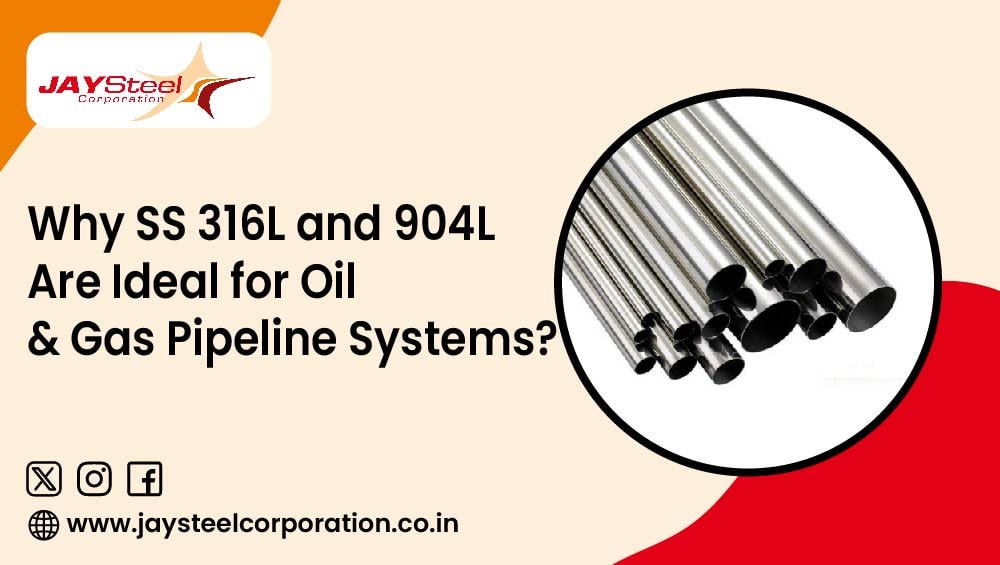In the demanding and corrosive area of the oil and gas industry, choosing the correct supplies for pipelines is crucial to ensuring safety, streamlining, and cost-effectiveness. At Jay Steel Corporation, we specialize in supplying high-performance stainless steel components that meet the difficult standards of the oil and gas sector. Two of the most reliable stainless steel grades we offer are SS 316L for oil and gas and 904L, both widely used in pipeline systems across the globe.
This blog explores why SS 316L and 904L stainless steel pipe systems are ideal choices and how to make an accurate choice for your focused applications.
Why Stainless Steel is a Preferred Choice in the Oil & Gas Industry
The oil & gas industry operates in environments filled with many harsh challenges, such as corrosive chemicals and high pressures, while also against fluctuating temperatures. Pipelines often transport inhumane oil, natural gas, water, and steady chemically treated fluids. In such cases, ingredients like carbon steel can degrade promptly, finest to leaks, failures, and high maintenance costs.
Stainless steel, particularly SS 316L and 904L, offers enormous advantages:
- Outstanding corrosion resistance
- High resource and durability
- Long service life in harsh environments
- Low maintenance conditions
- High thermal and pressure tolerance
SS 316L for Oil and Gas: Best Performance
What is SS 316L?
SS 316L is a low-carbon austenitic stainless steel with added molybdenum. The “L” indicates lower carbon content, which enhances weldability and reduces the risk of intergranular corrosion.
Features:
- Corrosion Resistance: Resists damage from chlorides, acids, and high-salinity environments—ideal for offshore platforms and coastal facilities.
- Beginner-friendly Fabrication & Welding: No post-weld annealing must, saving time and reducing fabrication costs.
- Inexpensiveness: SS 316L for oil and gas is more spending limit-warm than high-alloy steels while offering solid performance.
- Thermal Stability: Performs well in moderately high temperatures without losing mechanical strength.
Regular Applications:
- Subsea pipeline systems
- Pump shafts
- Heat exchangers
- Marine components and valves
904L Stainless Steel Pipeline: Maximum Corrosion Resistance
What is 904L?
904L is a high-alloy austenitic stainless steel originally planned for use in definitely corrosive environments like chemical plants. It contains higher amounts of chromium, nickel, molybdenum, and added copper, giving it prime corrosion resistance smooth in acetous or saline limitations.
Key Gains:
- Corrosion Resistance: Withstands strong acids (sulfuric, phosphoric), saline water, & chlorides.
- Long-Term Durability: Reduces the need for frequent repairs and shutdowns.
- High Strength: Maintains structure under high-pressure and any type of high-temperature conditions.
- Stress Corrosion Cracking Resistance: An important opportunity in deep-sea and high-sulfur gas transport.
General Applications:
- Deep-water pipelines
- Sour gas environments
- Oil refineries
- Chemical injection systems
SS 316L vs 904L in Oil Industry: A Similar Advisor
Choosing comparing SS 316L and 904L depends on your special use case, locale, and expected cost.
Performance Comparison Table:
| Feature | SS 316L | 904L |
| Corrosion Resistance | Very Good | Excellent |
| Cost | Lower | Higher |
| Chloride Resistance | Good | Exceptional |
| Acid Resistance | Moderate | Excellent |
| Weldability | Excellent | Good (requires expertise) |
| Mechanical Strength | High | Higher |
| Lifespan | Long | Very Long |
Key Takeaways:
SS 316L is true for ordinary oil & gas applications, exceptionally offshore and marine.
904L is recommended for entirely corrosive environments, where failure is not an option.
Pipeline Installation
A great offshore oil producer recently partnered with us to supply tons of SS 316L pipes for a new underwater pipeline routine. Thanks to the alloy’s terrific chloride resistance and durability, the project was concluded successfully with reduced material cost and maintenance concerns.
In one more case, a refinery operating in high-sulfur environments opted for 904L stainless steel pipe components to combat extraordinary acid corrosion, widening their maintenance cycle.
Final Perspectives: Trusted Us for Reliable Stainless Steel Options
Whether you’re comparing SS 316L vs 904L in oil industry tasks or organizing a new pipeline approach, choosing the true material can save you time, money, and risk. At Jay Steel Corporation, we supply both SS 316L for oil and gas and 904L stainless steel pipeline ingredients, assembled to meet global quality standards. Our proficient team can help you pick the excellent category derived from your application, corrosion risk, and budget.
Ready to achieve engagement? Contact us today for a custom quote or material meeting.
FAQs
Can SS 316L be used in sour gas service?
Yes, but only for mildly sour conditions. If the area is so acetous or contains high H₂S content, 904L or steady duplex/super duplex grades may become more compatible.
Is 904L worth the additional cost?
Absolutely, in intensive as well as challenging environments where corrosion can lead to an increase or raise the downtime or safety risks. Its longevity often outweighs the initial investment.
Which is less complicated to weld: SS 316L or 904L?
SS 316L is less difficult to weld and do. 904L can on top of that become welded yet may require experienced welders due to its higher alloy content.



